Cyprus offers plenty to do beyond sightseeing. Sporting activities benefit from a great climate and clear coastal waters, while entertainment ranges from some of the Mediterranean’s hottest nightclubs in Agia Napa to more sedate dance presentations or concerts in an ancient open-air amphitheatre or vaulted medieval building.
Sports
Beaches may not all have the best sands, but they do have crystal-clear, unpolluted seas. Hikers can find solitude and marvellous scenery in the unspoilt Troödos and Pentadaktylos mountains, or on the rugged Akamas Peninsula.
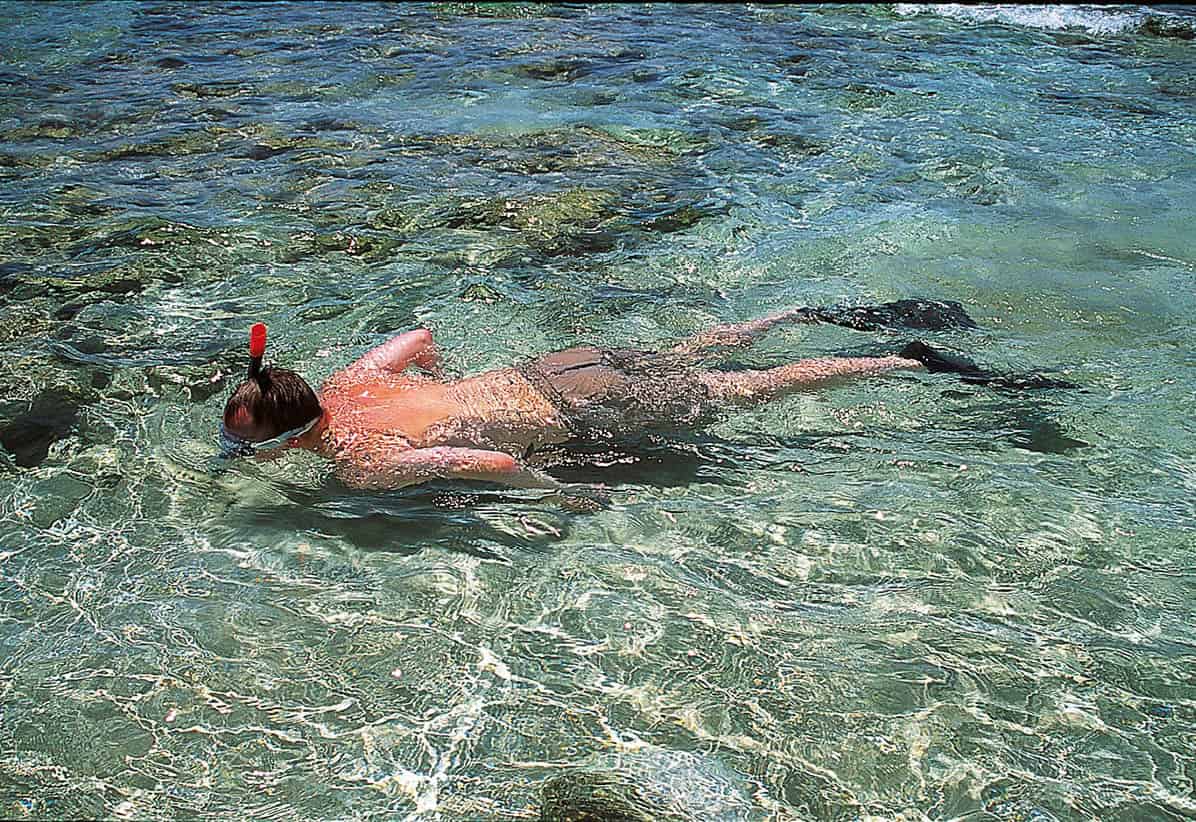
Clear water allows for great snorkelling
Caroline Jones/Apa Publications
Water Sports
Scuba divers and snorkellers are major beneficiaries of Cyprus’ limpid seas. In water temperatures ranging from 16°C (60°F) to 27°C (80°F), you can explore submerged cliffs, valleys and caves, and get close-up views of sea anemones, sponges and crustaceans (although colourful fish are not abundant in the nutrient-poor eastern Mediterranean). You can also dive over several wrecks, best of all the ferry Zenobia, which sank off Larnaka in 1980. You will find certified diving centres with equipment for hire and instruction at Pafos, Coral Bay, Lakki, Larnaka, Limassol, Agia Napa and Protaras in the South, and at Keryneia (Girne) in the North. One particularly good outfitter for the Zenobia wreck is Larnaka- and Limassol-based Dive-In (tel: 24627469; www.dive-in.com.cy).
Windsurfing is widely practiced, though conditions are best around Cape Gkreko, Pafos and Polis Bay; equipment can be hired at public and hotel beaches. Jet-skiing and parasailing are available at the main resorts. Those serious about sailing can hire craft from the harbours at Agia Napa, Pafos, Lakki, Larnaka, Limassol and Keryneia.
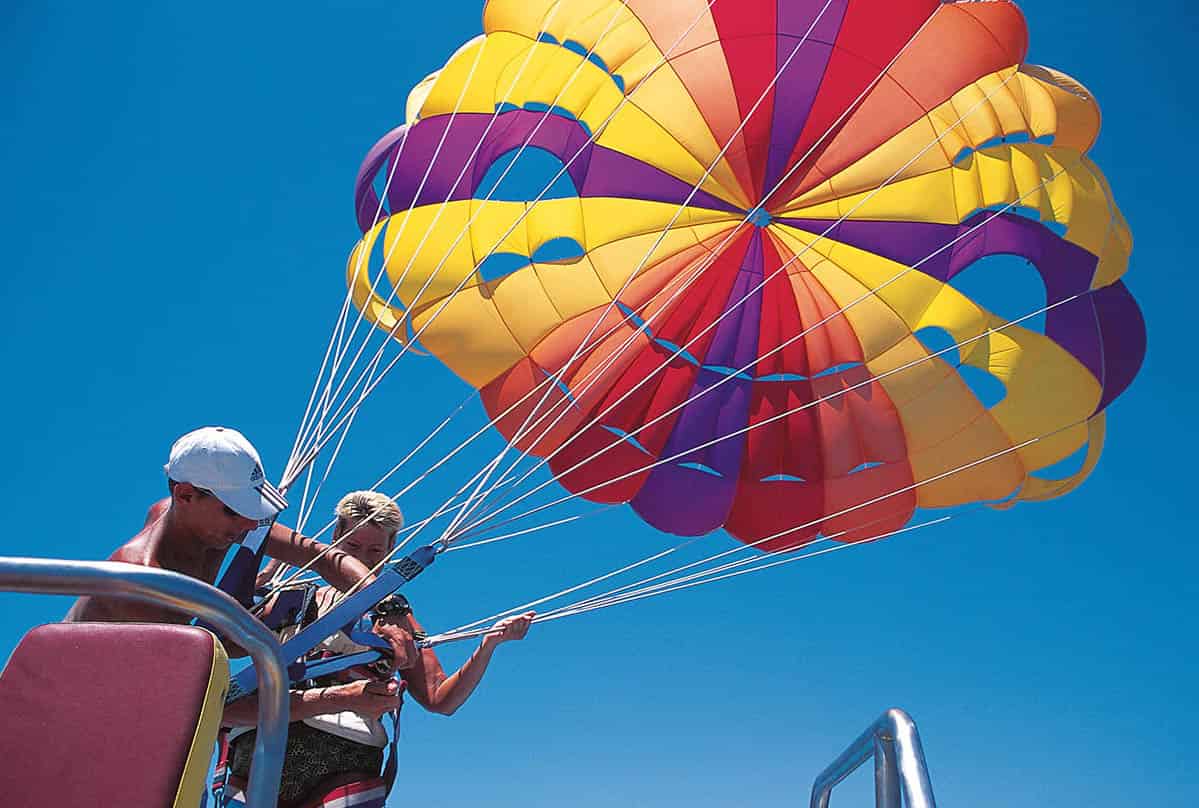
Parasailing off the beach at Agia Napa
Caroline Jones/Apa Publications
Golf
Golf is not a game much associated with Cyprus, but five excellent courses in the South are worth seeking out: Secret Valley, tucked away not far from Petra tou Romiou; Aphrodite Hills close by; Tsada, northeast of Pafos; and Vikla and Elias near Limassol. The North has courses at Pentageia (Yeşilyurt) and Agios Amvrosios (Esentepe).
Walking, Hiking and Jeep Safaris
The Troödos Mountains and Akamas Peninsula are ideal for hiking, though for most people it will be too uncomfortable in summer. The Cyprus Tourism Organisation has maps and information on local itineraries (for more information, click here). Visit the Pafos or Polis offices for the Akamas Peninsula, and the Pano Platres office for the Troödos Mountains. Ask at any CTO office for the excellent Nature Trails brochure, which maps out walks all over the south of the island. Adjacent to the Baths of Aphrodite car park, there’s a CTO placard that has details of walking trails; from here paths lead off into the Akamas – with the exception of the unmissable traverse of the Avgas (Avakas) Gorge, reached from the peninsula’s southwest shore. In the North, the Pentadaktylos Mountains look tempting, but few proper trails exist – only jeep tracks.
The most popular nature trails in the Troödos are the Atalante and Artemis ones around Mt Olympos, and the shorter hikes up to Kaledonia Falls or out to Makrya Kontarka along the Persephone trail, but better and more unspoilt is the loop route around Madari (Madhári) ridge, with the most accessible trailhead (and best parking) near Kyperounta (Kyperoúnda).
On Two Wheels
Fancy a spot of mountain-biking? Cyprus has the mountains, and you can hire bikes in all the main resorts. There’s little to stop you – except the fact that the grades are dauntingly steep, it’s going to be hot up there and the steed you’re riding will probably look as if it went through Cyprus with Richard the Lionheart.
If you’re sure you can hack it, there’s plenty of testing dirt tracks in the Troödos and Pentadaktylos mountains, on the Akamas Peninsula, around Cape Gkreko and in the wilds of Tillyria, Pitsilia and Karpasia. Take plenty of water and don’t overdo it in summer. Anyone of a less rugged disposition can content themselves with a relaxing cycle along the many quiet, paved and mostly flat minor roads close to the sea.
Jeep safaris into the Akamas region and the Pafos foothills, pioneered by now-defunct Exalt Travel, have become much of a muchness and indeed no new licenses for operators are being given, owing to their environmental destructiveness as carried out by most outfitters. For a more sensitive, entertaining and knowledgeable custom tour, visiting areas few outsiders ever see, contact Pafos-based licensed guide David Pearlman (tel: 99603513; email: taramas@cytanet.com.cy).
Horse Riding
There are a dozen reputable stables or riding clubs in the South, mostly around Limassol and Pafos, as horse riding (during the cooler months) has grown in popularity. The CTO’s Travellers Handbook lists them all; one to single out for lovely foothill itineraries and well-cared-for mounts is Drapia Farm outside Kalavassos village (tel: 99437188). There is also a decent stable in the North, at Agios Epiktitos (Çatalköy).
Winter sports
In winter, three drag-lifts and a chair-lift provide access to eight ski runs on Mt Olympos’ northeast slopes. Depending on snow conditions (which are usually poor), the ski season lasts from January to late March. Check current conditions on www.skicyprus.com.
Extreme Sports
You can augment the hazards of partying in Agia Napa with bungee-jumping at nearby Nissi Beach: the drop is 60 metres (200ft). The Slingshot, also in Agia Napa, claims to be the highest and fastest ride in the world. Riders are propelled to a height of 100 metres (300ft) in a breathtaking 1.3 seconds. Tandem paragliding is a spectacular option from the palisades of the hills above Keryneia (Girne).
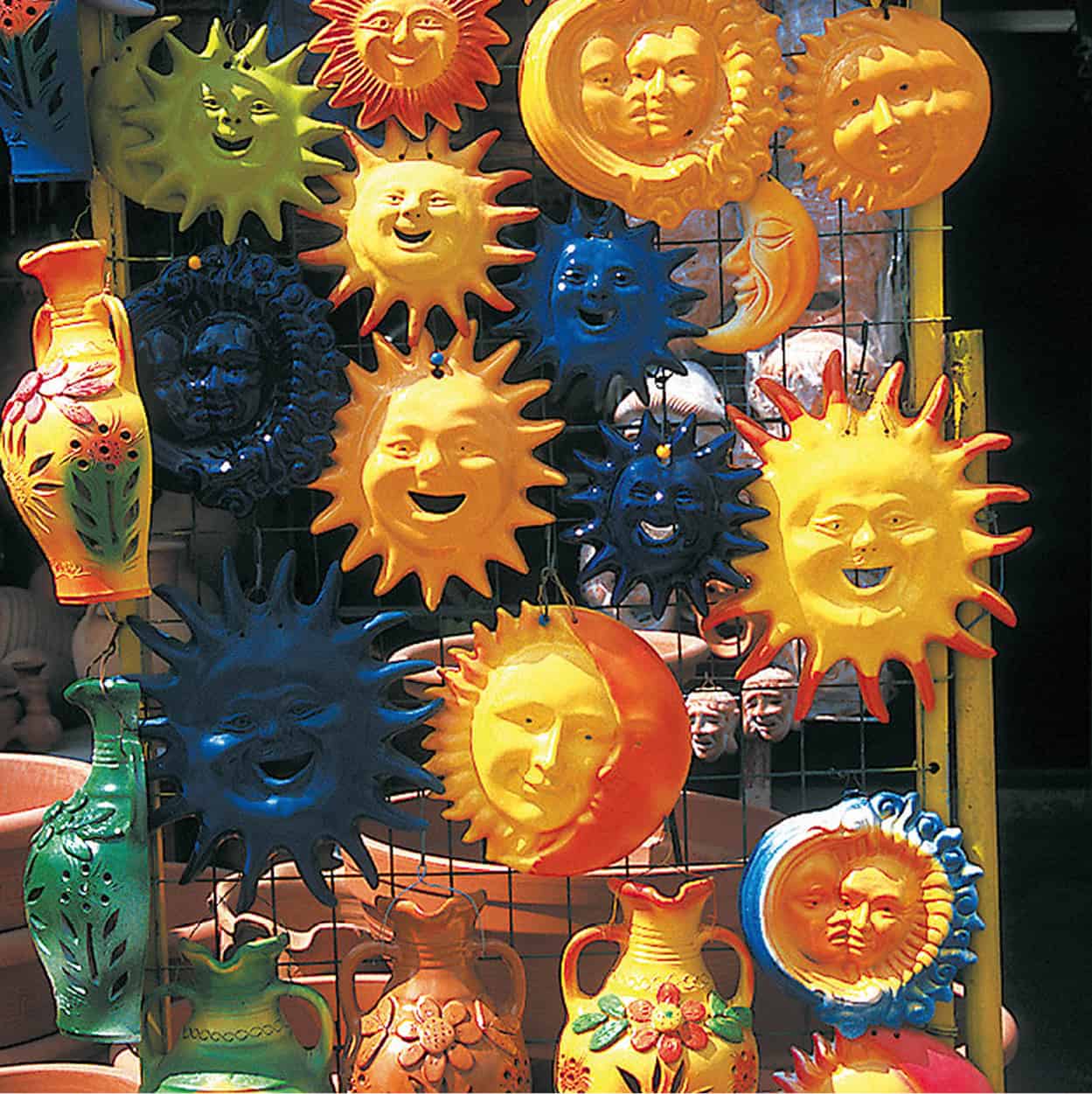
Colourful ceramic souvenirs
Paul Murphy/Apa Publications
Shopping
The quality of many tourist shops in Cyprus is low, tending towards cheap, imported tat. Head instead for the nearest Cyprus Handicraft Service (CHS) shop, showcasing the best of the island’s artisans. Goods here are comparatively expensive, but they are handmade and have the CHS label to guarantee it. You will find CHS shops at – Pafos: Apostolou Pavlou 64; Limassol: Themidos 25; South Nicosia: CHS workshop, Leoforos Athalassis 186; Larnaka: Kosma Lysioti 6. You can also find the works of talented craftspeople in various fields in their own shops and in outlets that stock quality products.
The giftshops of many of the South’s museums – in particular the Cyprus Museum in Nicosia, and the Pierides in Larnaka – have very covetable articles, in particular reproduction Byzantine/Lusignan ceramics. Subject to the import rules of your home country, don’t overlook a range of distinctive Cypriot foodstuffs and drink.
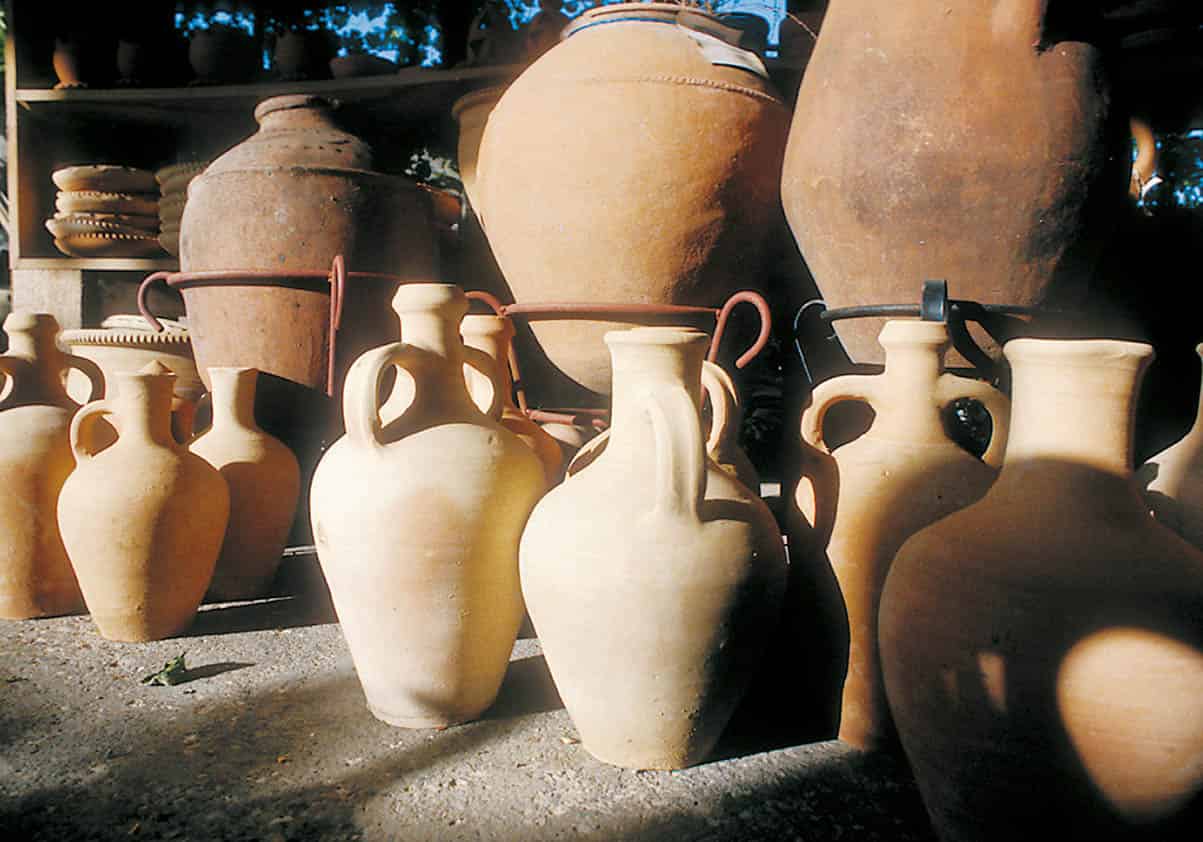
Terracotta urns for sale
Caroline Jones/Apa Publications
Best Buys
Basketry. The choice ranges from small baskets or trays, tsésti, in decorative shapes and colours to large articles in rush or cane.
Ceramics. Most ceramics are crude and garish. Seek out artisans who look back to antiquity for inspiration, or who are genuinely avant garde. Quality workshops/showrooms are scattered through the old Turkish-Cypriot quarters of Larnaka and Limassol.
Copperware. After three millennia, the copper industry remains a source of Cypriot pride. There are all manner of hand-crafted wares, including pots, saucepans and bowls.
Embroidery. Fine linen tablecloths, doilies, runners and handkerchiefs, stitched with the intricate geometric patterns of lefkarítika from Lefkara, and the more colourful pafítika from Pafos.
Food and wine. A sweet, jelly-like confection, loukoúmi, or ‘Cyprus Delight’, is a speciality of Geroskipou. The Turkish version, lokum, or ‘Turkish Delight’, is sold in the North. Well-sealed packets of loúntza (cured pork loin) travel well, as do carefully wrapped bottles of teratzómelo (carob syrup) – unbeatable on yoghurt, oatmeal or baked into muffins. Of the many wines and liqueurs produced in Cyprus, the most popular gift is the fortified red dessert wine Commandaria.
Icons. Pieces available range from exquisite works produced by highly skilled monastic artists, to the cheaper items on sale in most gift shops.
Jewellery. You can find good-quality silver and gold, but in the resorts quality can be poor. Unadulterated silver and gold articles must be hallmarked; learn what the hallmarks look like, and much more, at www.assay.org.cy.
Leather goods. Manufactured locally, shoes and sandals are reasonably priced in Cyprus.
Entertainment
Most resorts have a tourist-office brochure or a privately produced publication listing what’s on. Another excellent resource is the website www.cyprusevents.net.
Folklore Shows
Many hotels offer weekly folklore shows with costumed performers singing and dancing to traditional Greek tunes. Visitors are encouraged to get up and dance along. Many tavernas also have Greek-Cypriot or Greek dancing on a regular basis.
In Northern Cyprus, you may find (and be invited to engage in) belly dancing, and can enjoy Turkish music from enthusiastic – if not always terribly talented – local combos.
Nightlife and Agia Napa
Agia Napa is one of the Mediterranean’s major party destinations for clubbers, with options ranging from 1980s-revival nights to the latest sounds. In July and August the crowd is very much 18–30 and can get rowdy at times – if not downright homicidal. Agia Napa, sadly, is the South’s murder capital, and almost every year sees a fatal incident. The authorities have long operated a zero tolerance policy towards drugs, which has sent many patrons to Ibiza or Zakynthos. Outside the high season, you will find older, more discerning tastes being catered for.
The trendiest clubs change annually, but places like Castle (www.thecastleclub.com) or Black N White (www.napasound.com/club-black-white) seem able to keep up. Don’t go out too early – the real action doesn’t start until around 1am. Limassol and Nicosia also have respectable nightlife scenes, but Kato Pafos clubs are essentially over.
Historic Venues
The most memorable and distinctive evening’s entertainment on offer are those staged at ancient or medieval premises. The Pafos Odeion stages plays (in English), while the Fort is the venue for opera performances each September. Kourion’s amphitheatre is a wonderful place to catch a Shakespeare play or classical drama, or to hear a live concert (usually in July). Hire a cushion or take one along to sit at the outdoor theatres. Increasingly, Cyprus’ numerous acoustically excellent medieval buildings are being used as venues; don’t miss the chance to hear a chamber concert in the refectory of Bellapais Abbey, the undercroft of La Cavocle at Kouklia, or the Kasteliotisa hall in old Nicosia. Nearly as impressive are revamped 20th-century structures, like the Rialto Theatre in Limassol (http://rialto.interticket.com) and the Shoe Factory or the Municipal Theatre in Nicosia.
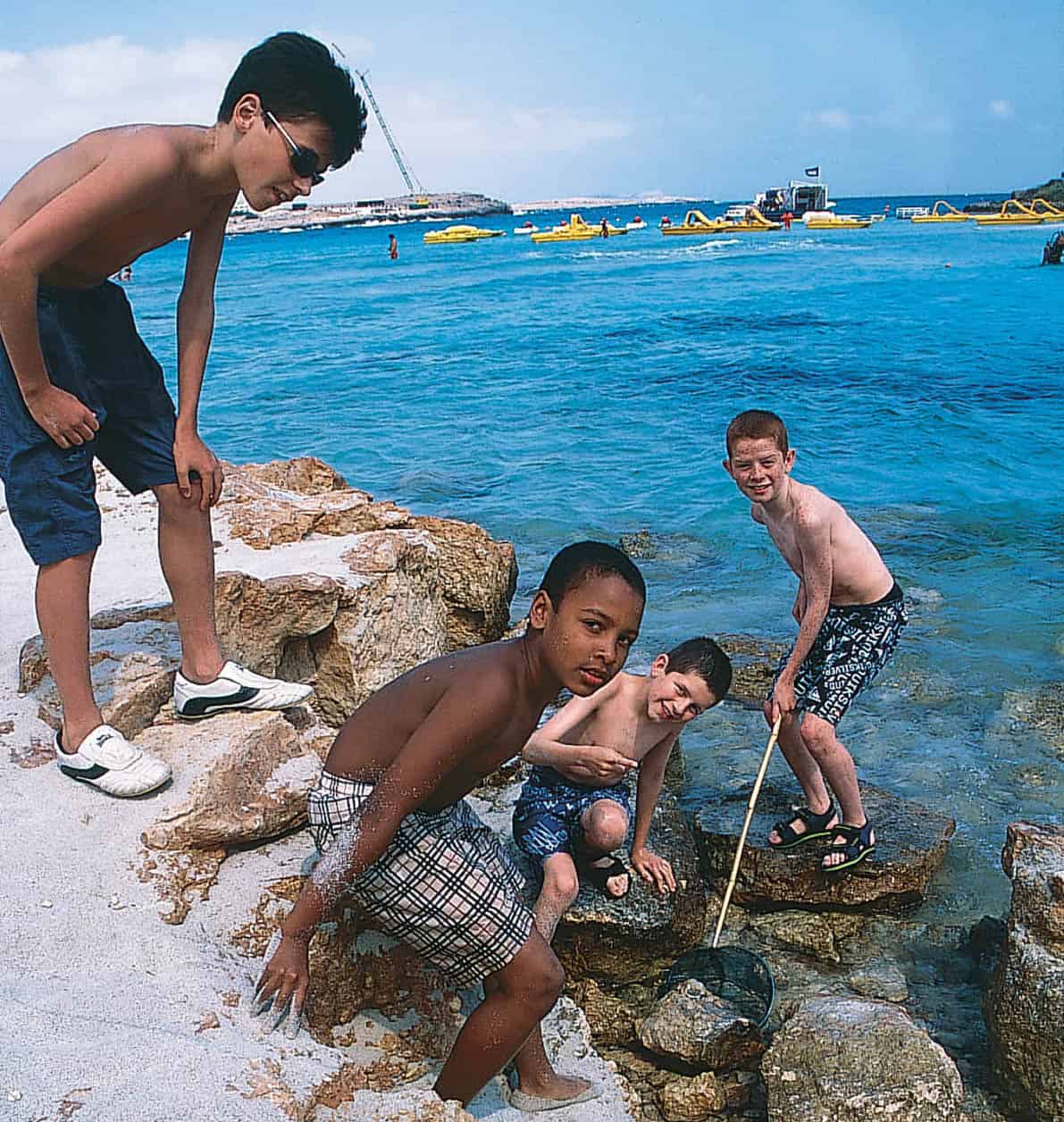
Rockpooling on Nissi Beach
Caroline Jones/Apa Publications
Children’s Cyprus
With clean beaches and endless sunshine, Cyprus is great for children (but be sure to protect them from the fierce Mediterranean sun). Cypriots, like most southern Europeans, love children and there are few, if any, restrictions on where they can go.
If the kids are bored with the beach, but not with the water, there are four waterparks to experience. WaterWorld (www.waterworldwaterpark.com), just west of Agia Napa at Agia Thekla, claims to be the biggest in Europe, with over 20 Greek-mythology-themed rides, ranging from high-speed thrill chutes to the Lazy River. There are three other waterparks in the South: Wet ’n’ Wild, just east of Limassol, is larger and wilder than Watermania (www.fasouri-watermania.com) at Fasouri. The Paphos Aphrodite Waterpark (www.aphroditewaterpark.com) between Pafos and Geroskipou also has its superlatives, including a long rafting ride.
The biggest and best amusement park is Paliatso Fun Fair Luna Park (www.parkopaliatsocy.com) in Agia Napa. Kids will also enjoy a chance to view the underwater world from a glass-bottomed boat, such as the 30-seat Yellow Submarine, which operates from Agia Napa.